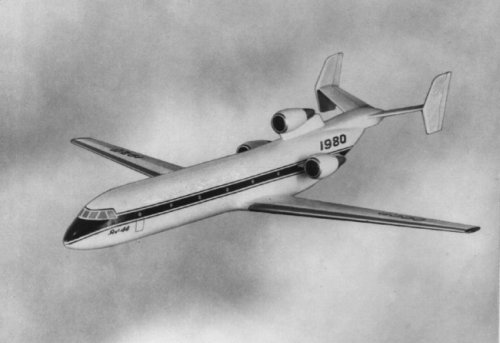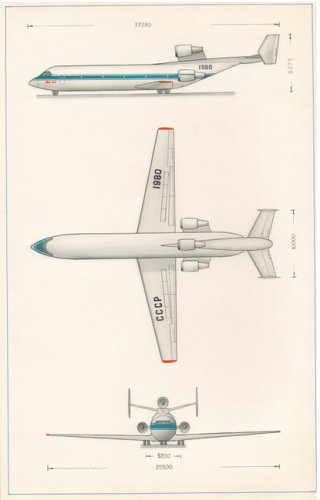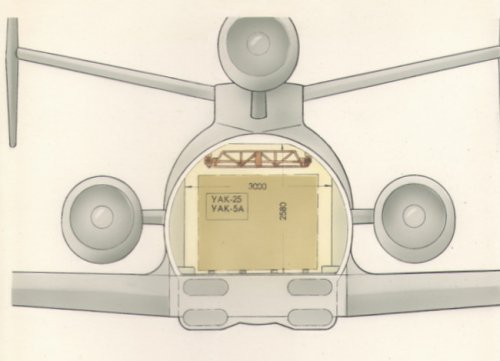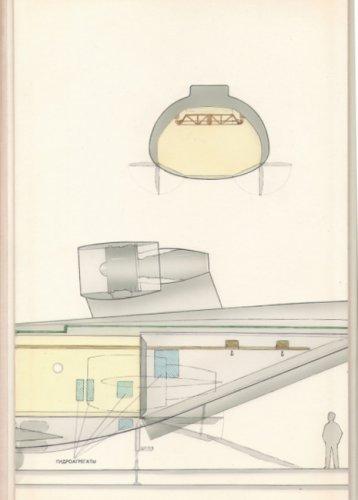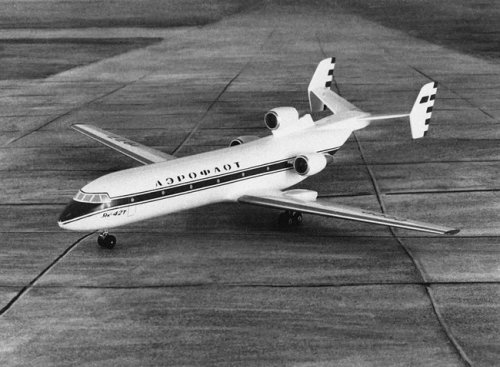Unidentified projects: Yak-42 as a "truck"
September 22, 2015 / The magazine "Wings of Motherland" / Aviation EXplorer
Share
print version
The airliner Yak-42 is among the well-known and recognized the achievements of the domestic aviation industry. Made its first flight on March 6, 1975, it entered service in spring 1980, and served for more than three decades in the domestic and foreign airlines as passenger short- and medium-haul aircraft, making a good reputation among passengers and operators (for a number of Yak-42 He continues to fly in Russia to this day). In addition to the carriage of passengers, it served as the basis for the creation of flying laboratories for different purposes. The history of the construction of the Yak-42 and its use is described in the article, the author of the monograph, published in the "Aviation and Time" magazine №5 in 2014.
On the basis of this first pilot of the Yak-42 (with a direct wing) developed freight options
The volume of the article is not allowed to give sufficient attention to the creation of numerous projects based on the Yak-42 military transport and cargo aircraft. These projects remain unrealized, contained a lot of original solutions and are of historical interest. On them will be discussed in this article.
Work on the transport version of the Yak-42 was carried out from the beginning of its design after 1972 he received the job to the plane of the MGA. The first study of the Yak-42 passenger versions at 64-96, depending on the layout of the cabin, with a powerplant of two engines D-30K (at least - three engines at traction) power plant of three new at that were soon abandoned and adopted the time of D-36. It is this power plant was laid in the preliminary design of the Yak-42, submitted to the MCA in December 1972 Since the EDO at that time there was no definitive opinion regarding the appropriateness of this aircraft swept wing, the project involved two options: direct wing (sweep through fourths chords 11 degrees, the trailing edge of a straight line) and with a swept wing (sweep through fourths chords 25 degrees). This approach was reflected and built at the same time a full-size layout, which was on the left side straight wing, and on the right - swept. As a result, consideration of the project it was decided to take for the future of passenger aircraft swept wing (which was implemented in the future). However, the first prototype was still built with straight wings, but he was the only one of its kind. All passenger Yak-42 were built with swept wings.
Right wing, however, for some time had "favorite" in the design of the Yak-42 transport options, although these options later designed and with swept wings.
Already in 1972, the pilot project provided that the original passenger Yak-42 will serve as a basis for the creation of a transport plane with a side cargo door and landing and sanitation options.
Equipment large passenger jet aircraft side cargo door was first implemented back in 1963 in the United States, where there was a plane Boeing 707-320C (Converrtible) with a door on the left side. Later, similar options are designed on the basis of Boeing-727 and -737. We have the same Yakovlev, perhaps, the first to implement this solution first on a relatively small Yak-40, and then projected it and the Yak-42, which, however, is not embodied in the metal. Somewhat later, in 1978, the OKB Ilyushin Il-62Gr project with the cargo hatch dimensions 3,5h2,0 m in the forward fuselage was produced (realized only in 2002). In the first half of the 1980s. cargo door was fitted with the Tu-154C (Sargo), even later - Tu-204C and converted Il-18Gr, and in 1996 - Il-114T, and finally, in 2006 - Il-96-400T.
The cargo door on the plane Yak-40K
But back to the mentioned pilot project. The preliminary design review of the Protocol (document 47 / 31a in the library OKB. Yakovlev) had a special section "Military applications of aircraft Yak-42." As it was noted that the three variants of the aircraft have been worked out for military use:
- Transport for container cargo weighing up to 12.5 tonnes;
- Landing on the 99 paratroopers;
- Sanitary 60 beds and 3 paramedics
It provides for the possibility conversion of passenger aircraft to any of these options in the field for 24 hours without alterations and design improvements. "To this end, it provides on-board cargo door size 2060h2200 mm (NB - in the pilot project - 2050h2200 mm) quick release and transport, landing and sanitary facilities.
The plane with a side cargo door Tu-154S
The plane with a side cargo door Tu-204C
Curiously the following remark: "air landing of people and goods is made on the tested and proven in the GK NII VVS aircraft Yak-40 system." (The author has no information about this system).
The document further stated: "The aircraft provides transportation ground assault, the wounded and cargo unpaved airfields."
Further information can be obtained from layouts of cargo, sanitary and landing options are available in the preliminary design and the Protocol review board layout (documents 47 / 30-1a and 47/32 of EDO library).
In the embodiment shown the cargo container 24, placing the three groups of eight containers on roller tracks 4, with the corresponding mooring; in the doorway of the loading door telescoping jib extends, allowing to lift loads from the ground to the level of the floor of the cargo compartment.
The sanitary embodiment are mounted along each side of the rack 6, each of which consists of three stretchers; 6 more shelving in the stretcher 4 each are located on the centerline of interior lines, which gives 60 stretcher places.
In the embodiment, the troop seats for paratroopers are grouped into 24 sections by 4 places, which gives 96 seats three individual places, a total of 99. In this case, 6 sections are placed along each side and 12 sections along the center line of the cabin in the form of 6 blocks of two sections " back to back".
The plane with a side cargo door Il-114T
The plane with a side cargo door Il-96-400T
In 1974, MGA has developed "Terms of Reference for the cargo version of the plane near the main Yak-42." The following year, the Design Bureau developed the project cargo-passenger Yak-42 with straight wings to transport loads up to 15 tons.
Variants Yak-42 pilot project for 1972 (top to bottom):
Transport with a side cargo door; landing; sanitary
The project Yak-42 with a large cargo door and right wing
Ski gear on the Yak-42 with a large cargo door
(Skis with pointed toes)
The plane was on the draft have the following information: takeoff weight - 52 tons, the maximum load - 15 tons, flight height - 8 km, cruising speed - 750 km / h, flight range with a load of 15 tons - 1000 km, with a cargo of 10 tons - 2100 km length of the runway - 1800 m / On the left side was arranged opened up gruzolyuk 2050h3200 size mm (in some design drawings shows gruzolyuk size 2050h2200 mm in preliminary design.).. For the mechanization of cargo handling works envisaged jib and winch.
The diagrams and drawings of the project can be further gleaned the following details:
The cargo hatch was located on the left side in the bow and included the first three windows, cargo-passenger cabin. When loading / unloading hatch reclined up, I put forward in the doorway Assigned to the ceiling overhead crane lifting capacity of 1 m, which allowed to lift loads from the ground or from a truck platform. Sex truck cabin is equipped with roller tracks. Loads must be transported on pallets to package type I and II OTT-3-72, as well as in bulk. Under the floor were placed 8 standard type Boeing 727 containers. The sealed cargo hold had heating. In pure cargo version in it was placed 8 pallets. The use of a special truck allowed to raise the level of the cargo compartment floor pallets and overload them into the opening of the hatch. Retracting a board passenger seat allows you to easily change the layout of the aircraft, depending on the amount of goods and passengers. In addition, as is evident from the drawings, in cargo-passenger version in the rear 36 seats were installed instead of three pallets. In this embodiment, the plane could take other than passengers, 11.5 tons of cargo.
Mixed cargo-passenger Yak-42 layout with a large cargo door
The project provided for the possibility of equipping the cargo-passenger Yak-42 ski gear. Ski option was to provide aircraft operation in the northern regions of the European part of the USSR and Siberia in the airfield and vneaerodromnyh conditions in the presence of a continuous snow or ice. Replacement wheeled chassis on skis was carried out in the field.
I must say that equipping ski gear jet transport aircraft of this class - with Flight weighing 40-50 tons - was the work of a very unusual, like the concept of the use of aircraft with landing gear in regular freight traffic. The author is not aware of the existence of other similar projects in the USSR or abroad at the time (1974). However, by itself the use of skis in the heavy transport aircraft was not a novelty. There were options for ski transport aircraft An-12 in the USSR and the US Lockheed C-130, exceeding the Yak-42 on take-off weight (AN-12 - 56 m, C-130 - 65-70 tons). Back in 1961 in the USSR was tested in duplicate AN-12FL plane (polar, ski), equipped with non-retractable ski gear and warm air heating system skis with their freezing machines for breakaway from their seats. In 1967 the plane An-12 Soviet-11381 was placed on the new ski designs that differ from the sample in 1961 by its shape and the device - were equipped with a braking device. The aircraft was tested in 1967 on the river. Kolyma.
The Americans successfully exploited in Antarctica famous transport C-130 (in the LC-130 version), equipped with a combined wheel-ski landing gear.
It should be borne in mind that as the AN-12 and C-130 turboprop aircraft and were, moreover, intended to be used with ski gear in the Antarctic, and not for commercial traffic.
Ski chassis trucks Yak-42 was supposed to do poluubirayuschimsya. Ski nose gear is urged to the forward fuselage, the main landing skis - to the center section. On the design drawings are two types of skis are shown. In one embodiment, ski socks have a pointed slightly in shape, another leading edge of the nose was straight skis. Ski gear, as well as the project itself is the cargo version of the Yak-42, to implement were not adopted.
Since 1987, the Design Bureau developed on the basis of serial Yak-42D several projects of transport vehicles. Thus, in the official history of EDO it stated that "has been developed design documentation of a convertible version of the Yak-42AK, providing for the transportation of oversized cargo, which was designed by the size of the hatch 3200h2000 mm. Much work has been done on the design of sanitary and transport aircraft (Yak-42ST). "
It was developed in the Yakovlev Design Bureau and ramp aircraft. In 1975, on the basis of the first prototype of the Yak-42 with a straight wing was drafted ramp transport aircraft, the designation Yak-42T. Probably, in the framework of this topic it was made a full-size mock-up of the fuselage equipped with a ramp and cargo compartment. Average engine on the layout of the fuselage was located at the base of single-fin vertical tail to make room for the cargo ramp respectively in the extended rear fuselage. However, during the design there was another, rather original layout of the rear part of the Yak-42T with two-keel fins and placing the middle of the engine on the pylon above the fuselage. Main landing gear retracted into the wing nacelle according to the type of machinery Tupolev Tu-104, -124, -134, -154, as seen on the model of the Yak-42T.
Ski gear on the Yak-42 with smaller cargo door (skis with square toes)
The revised draft form, dated 1976 year, received the designation Yak-44. Its maximum takeoff weight rose to 60 tonnes and lifting capacity -. 20 m plane was supposed to take an intermediate position between light-duty aircraft An-26, Yak-40K heavy-duty aircraft and Il-76 and was intended to replace the aircraft AN-12. The layout of the aircraft and aircraft provided the means of mechanization of loading and unloading of cargo in containers VAR-5A VAR-2.5, on pallets PA-5,6, PA-2,5, wheel self-propelled and self-propelled machinery, heavy and long goods; It provides for the carriage of goods in bulk. The cargo area has the following dimensions: width 3.0 m, height 2.58 m, length 16.2 m.
Airborne mechanization consisted of a floor-mounted mechanization, providing moving and securing cargo in the cargo bay, and two crane lifting capacity of 2.5 tons beams that allow for loading and unloading from any vehicle.
The power plant consisted of three aircraft turbofan engines D-36A with a thrust of 6850 kg, mounted on the tail section of the aircraft. For stand-alone engine start and ensuring autonomous power supply on-board means of mechanization under the floor of the cargo compartment installed auxiliary power unit TA-6B. Fuel housed in the wing box.
Unlike the original Yak-42T, the main landing gear began to clean the center-turn to the fuselage. It provides for the possibility of machine operation from unpaved airfields. For ease of loading and unloading operations conceived "squat" on a plane 480 mm.
Yak-42 with a small cargo door, the ski chassis in cargo-passenger layout
The full-size mock-up of the Yak-42 fuselage in the cargo version with rear ramp
Interior view of a cargo compartment on the same layout
We give the main technical data of the project.
transport aircraft model Yak-42T (see the gondola chassis on the rear edge of the wing)
The project Yak-42T in the amended form was designated Yak-44. In this figure, there are no Gondola chassis
(Landing gear retracted into the fuselage)
The Yak-44 had a straight wing trapezoidal shape in the plan, almost identical in outline wing aircraft Yak-42M USSR, 1974. The design of the caisson type wing Permanently. Adjusting the angle of the wing three degrees, the angle of the transverse V - +3 degrees. On each console, two trёhschelevyh flap fitted, ailerons spring servokomipennsatorom and spoilers.
Design options Download Yak-44
Design a three-branch pattern Yak-44
The layout of the Yak-44 cargo compartment (rear view)
The fuselage - semi-monocoque stringer. The forward fuselage (to the frame 16) is taken from the series Yak-42. It housed the crew cabin, equipment compartments, a compartment for individuals. accompanying the goods. Between frames 20 and 59 is the cargo bay. The bulkhead 59 is mounted rotary germostvorka, which ensures tightness of the cargo compartment. And in the tilted position is a cargo ramp. The tail end of the fuselage sliding doors. Installation of ramp gruzolyuka entailed a radical reworking the rear fuselage. The width of the fuselage in this portion is increased accordingly. Since the mid-engine layout of the former has become impossible, it was moved to the top of the fuselage and pushed forward by setting the pole is almost flush with the outboard engine. It would be possible to put a third engine at the base of the keel, like an airplane McDonnel Douglas DC-10 (which is provided in the above-mentioned full-scale mockup of the cargo version). However, OKB prefer in this case dvuhkilevoe plumage, which is to be installed over the ramp gruzolyukom made overhanging "beam" impressive elliptical cross-section). Apparently, the layout type DC-10 created a problem with providing strength tail. Since the tail boom was given a small elevation angle, middle pole motor had to be supplied with the same negative angle to the horizontal of the fuselage construction. This, on the one hand possible to avoid hitting the jet on the horizontal stabilizer, and the other - to reduce the diving moment generated by high-engine. The length of the aircraft slightly increased in comparison with passenger option, while maintaining the same wingspan.
Stabilizer dvuhlonzheronnoe design, the adjustable in flight from +4 degrees. . To -8 degrees, it was made swept, pitching washers - with the front edge of the double sweep. Later, a similar configuration of the tail has been applied on a plane AN-225.
Cargo ramp Yak-44. In the retracted position serves as germostvorki
Chassis tricycle scheme was carried out with the expectation of service as a concrete strip and unpaved airfields with 8-9 kg / cm2 soil strength. The front leg of the lever-type chassis with two wheels controlled. Main landing gear leg had rack telescopic type and four-wheel cart. For ease of loading and unloading and reduce the height of the loading floor chassis adapted replanting amortstoek 480 mm. Installing the chassis replanting made it possible to reduce up to 1670 mm height of the floor of the cargo hold above the ground.
Here are the basic details of the Yak-44 project: wingspan - 35.5 m; length - 37.38 m; takeoff weight - 60.0 tons; maximum load - 20.0 m; Normal load - 14.0 m; cruising speed - 700 km / h; flight range with a maximum load of 20 tons - 700 km, with a normal load of 14.0 tons - 2,000 km, with a maximum fuel capacity and a load of 6.4 tonnes - 3700 km.
Sergey Komissarov, deputy chief of the "KR" editor
The author is grateful for their assistance in preparing this article Y. Zasypkina and E.I.Gordon
The magazine "Wings of Motherland"
AEX.RU

